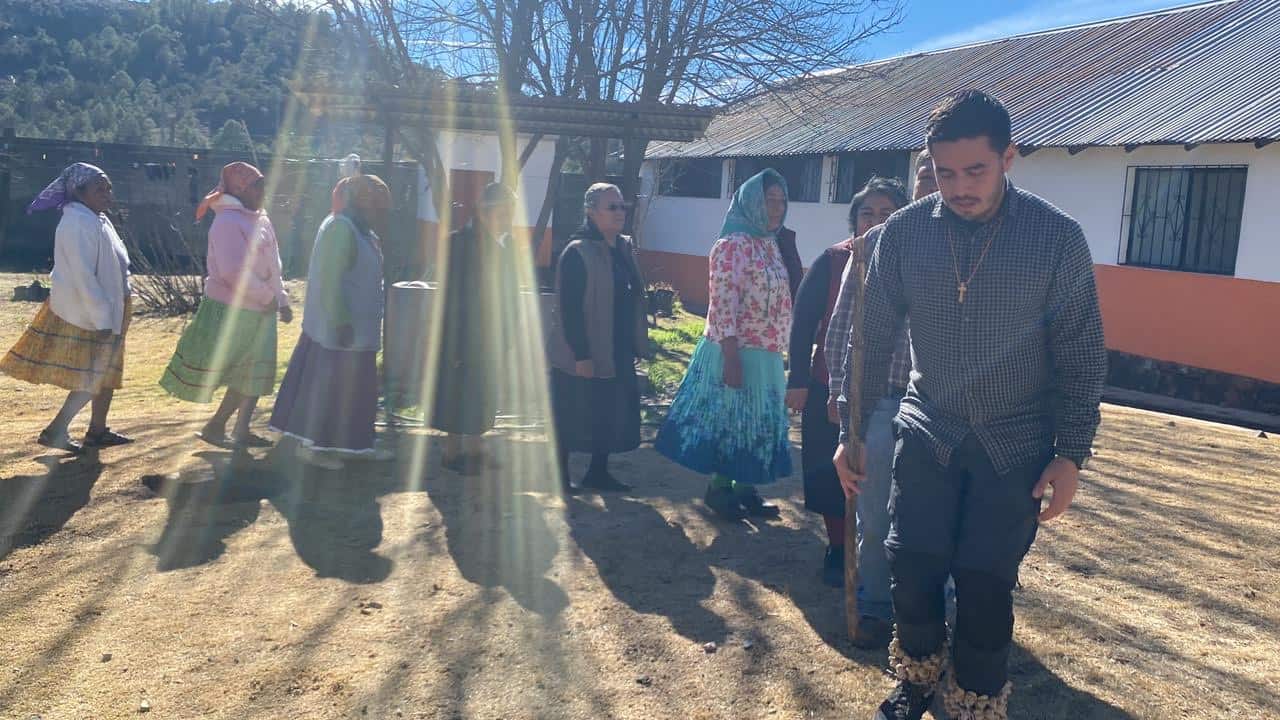I was supposed to start my new assignment in December. My flight was scheduled, and my things (art material, some books, and my winter clothes) were sent… but my thesis was still not finished. Everything got canceled, and I felt as if I hadn’t fulfilled my first mission as a Jesuit. Sadness and frustration took hold of my heart, but prayer helped me out of this deep desolation: Writing Rublev’s icon of the Holy Trinity helped me in my daily prayer during this hard time. 1 God let me know I haven’t failed at all; I just had a little delay. Only through the lens of prayer I recognized that God was there, sitting next to me in my despair and loneliness.
I had some time with my family and friends before departing to the Tarahumara Sierra, and all of them talked to me about their concern and fear of me leaving for Cerocahui. I always told them the truth: I was a little bit afraid too. But I also felt an enormous desire to leave soon. So, I went to Chihuahua and after some days with Fr. Esteban Cornejo S.J., pastor of Cerocahui and one of the two witnesses of the murder. 2
We departed Chihuahua early, but our red truck, named “Camelia” by Fr. Joaquín Mora SJ, had trouble after we passed “La Junta” (the city that marks the entry to the road that takes you to the Tarahumara Sierra). Snow was waiting for us in the distance, and we had to stay there and wait for the help sent from Creel (one of the biggest cities in the Sierra, it’s a tourist destination, and home to a Jesuit hospital named “Santa Teresita”). Camelia stayed at Baqueachi, next to La Junta. We left for Creel in a new vehicle and the National Guard was waiting for us. Fr. Esteban told me that the agents were going to get us to Cerocahui. I was very uncomfortable, afraid of a possible encounter between narcos and the agents. My mind was building a bunch of scenarios that involved a CSI kind of scene. I was missing what I most enjoyed in the times I had been in the Tarahumara Sierra: the impressive landscape. Again, God took me out of my paranoia and let me enjoy the happiness of finally being here.
We arrived at dusk. The first thing I did was get inside the Church because I wanted to stand where Javier and Joaquin were killed, where the outrageous violence in Mexico reached the Church. I could no longer keep the tears and I cried, and as tears rolled down, I was very thankful for finally being there. The next day we were celebrating the Candelaria velación, the Feast of the Epiphany of our Lord. Martin, the Rarómari authority in the community, arrived after 9am. Few people came and gathered in the patio of the Jesuit house that’s next to the church. Martin knew me from that time I was here, and he asked me: Do you want to wear the chayéwaris?
Chayéwaris are traditional bells made from butterfly shells gathered in the lower parts of the canyon. They are filled with seeds and tied together. The cord is attached to the shin, and you have to step hard to make sound along with the rhythm of the violin.
I said yes. And so, I was the pascolero, or dance leader 3 of the party. Dancing is the way the Tarahumara people pray. The dance, the feast and the tesgüino (a beverage made by germinated corn, cooked, grounded, and fermented by a wild oat they use, it’s “God’s water”) are what God, Onorúame as they call Him, wants us to do so we can help him to harmonize the world. Sustaining the world is one of the missions that the Rarámuri indigenous people have, it is what God gave them as a way of living. They do so in their way of being Christians.
And so, I danced with passion, I really prayed with my dancing, because I realized their way is the only possible way to fight the violence that took hold of this beautiful place. The people invited me into their way of living poorly, of believing in a poor God that needs from us, of praying with dance and tesgüino for making the world even. The people of the Tarahumara Sierra ask us to have faith: that God walks with us, and we need Him, that this mission needs us more than ever, that Javier and Joaquin help us from where they are now, they give us strength. They ask me to have faith in believing that we don’t walk alone. As I danced, Javier’s voice sounded in my heart: ¡Don’t be afraid!
-//-
Photo courtesy of the author.
- Sebastian has previously written about his prayerful experience of writing icons. ↩
- Two elderly Mexican Jesuit priests were murdered last year in Cerocahui. ↩
- Pascol is a traditional dance of the Tarahumara people. It’s named after Pascua, Passover. ↩

